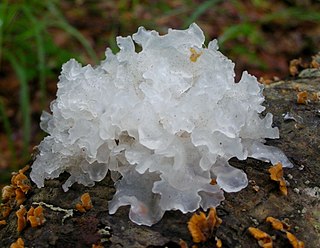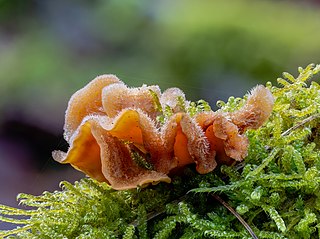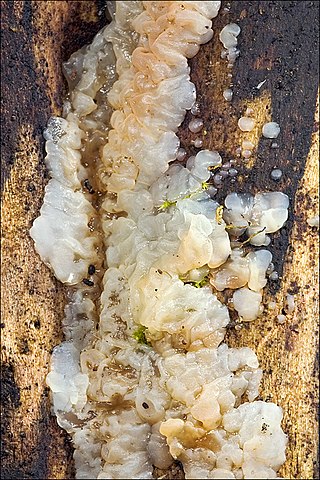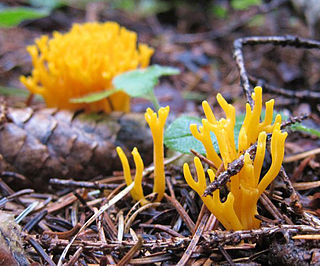
Tremella fuciformis is a species of fungus; it produces white, frond-like, gelatinous basidiocarps. It is widespread, especially in the tropics, where it can be found on the dead branches of broadleaf trees. This fungus is commercially cultivated and is one of the most popular fungi in the cuisine and medicine of China. Tremella fuciformis is commonly known as snow fungus, snow ear, silver ear fungus, white jelly mushroom, and white cloud ears.

Wood-ear or tree ear, also translated wood jellyfish or tree jellyfish, can refer to a few similar-looking edible fungi used primarily in Chinese cuisine; these are commonly sold in Asian markets shredded and dried.

Tremella mesenterica is a common jelly fungus in the family Tremellaceae of the Agaricomycotina. It is most frequently found on dead but attached and on recently fallen branches, especially of angiosperms, as a parasite of wood decay fungi in the genus Peniophora. The gelatinous, orange-yellow fruit body of the fungus, which can grow up to 7.5 cm (3.0 in) diameter, has a convoluted or lobed surface that is greasy or slimy when damp. It grows in crevices in bark, appearing during rainy weather. Within a few days after rain it dries into a thin film or shriveled mass capable of reviving after subsequent rain. This fungus occurs widely in deciduous and mixed forests and is widely distributed in temperate and tropical regions that include Africa, Asia, Australia, Europe, North and South America. Although considered bland and flavorless, the fungus is edible. Tremella mesenterica produces carbohydrates that are attracting research interest because of their various biological activities.

The Agaricomycetes are a class of fungi in the division Basidiomycota. The taxon is roughly identical to that defined for the Homobasidiomycetes by Hibbett & Thorn, with the inclusion of Auriculariales and Sebacinales. It includes not only mushroom-forming fungi, but also most species placed in the deprecated taxa Gasteromycetes and Homobasidiomycetes. Within the subdivision Agaricomycotina, which already excludes the smut and rust fungi, the Agaricomycetes can be further defined by the exclusion of the classes Tremellomycetes and Dacrymycetes, which are generally considered to be jelly fungi. However, a few former "jelly fungi", such as Auricularia, are classified in the Agaricomycetes. According to a 2008 estimate, Agaricomycetes include 17 orders, 100 families, 1147 genera, and about 21000 species. Modern molecular phylogenetic analyses have been since used to help define several new orders in the Agaricomycetes: Amylocorticiales, Jaapiales, Stereopsidales, and Lepidostromatales.

Stereum hirsutum, also called false turkey tail and hairy curtain crust, is a fungus typically forming multiple brackets on dead wood. It is also a plant pathogen infecting peach trees. S. hirsutum is in turn parasitised by certain other species such as the fungus Tremella aurantia. Substrates for S. hirsutum include dead limbs and trunks of both hardwoods and conifers.

The subdivision Agaricomycotina, also known as the hymenomycetes, is one of three taxa of the fungal division Basidiomycota. The Agaricomycotina contain some 20,000 species, and about 98% of these are in the class Agaricomycetes, which comprises most of the fungi known as mushrooms, including the bracket fungi and puffballs. Species in the Agaricomycotina that are not Agaricomycetes include the jelly fungi, certain "yeasts", ear fungi, and others; these are gathered together as the classes Tremellomycetes and Dacrymycetes. Numerous species of Agaricomycotina are able to produce multicellular fruiting bodies, however, resupinate species form a hyphae structure. Yeast-forming species do not have the capacity to produce fruiting bodies.

The Auriculariales are an order of fungi in the class Agaricomycetes. Species within the order were formerly referred to the "heterobasidiomycetes" or "jelly fungi", since many have gelatinous basidiocarps that produce spores on septate basidia. Around 200 species are known worldwide, placed in six or more families, though the status of these families is currently uncertain. All species in the Auriculariales are believed to be saprotrophic, most growing on dead wood. Fruit bodies of several Auricularia species are cultivated for food on a commercial scale, especially in China.

The Auriculariaceae are a family of fungi in the order Auriculariales. Species within the family were formerly referred to the "heterobasidiomycetes" or "jelly fungi", since many have gelatinous basidiocarps that produce spores on septate basidia. Around 100 species are known worldwide. All are believed to be saprotrophic, most growing on dead wood. Fruit bodies of several Auricularia species are cultivated for food on a commercial scale, especially in China.

Auricularia is a genus of fungi in the family Auriculariaceae. Basidiocarps are typically gelatinous and ear-shaped, with a slightly downy to conspicuously hirsute upper surface and an under surface that is smooth, wrinkled or veined. All species grow on wood. Several Auricularia species are edible and commercially cultivated on a large scale in China and East Asia.

Tremella is a genus of fungi in the family Tremellaceae. All Tremella species are parasites of other fungi and most produce anamorphic yeast states. Basidiocarps, when produced, are gelatinous and are colloquially classed among the "jelly fungi". Over 100 species of Tremella are currently recognized worldwide. One species, Tremella fuciformis, is commercially cultivated for food.

Exidia glandulosa is a jelly fungus in the family Auriculariaceae. It is a common, wood-rotting species in Europe, typically growing on dead attached branches of oak. The fruit bodies are up to 3 cm (1.2 in) wide, shiny, black and blister-like, and grow singly or in clusters. Its occurrence elsewhere is uncertain because of confusion with the related species, Exidia nigricans.

Ascocoryne sarcoides is a species of fungus in the family Helotiaceae. The species name is derived from the Greek sarkodes (fleshy). Formerly known as Coryne sarcoides, its taxonomical history has been complicated by the fact that it may adopt both sexual and asexual forms. Colloquially known as jelly drops or the purple jellydisc, this common fungus appears as a gelatinous mass of pinkish or purple-colored discs. Distributed widely in North America, Europe and Asia, A. sarcoides is a saprobic fungus and grows in clusters on the trunks and branches of a variety of dead woods. Field studies suggest that colonization by A. sarcoides of the heartwood of black spruce confers some resistance to further infection by rot-causing fungi. A. sarcoides contains the antibiotic compound ascocorynin, shown in the laboratory to inhibit the growth of several Gram-positive bacteria.

Exidia nigricans is a jelly fungus in the family Auriculariaceae. It is a common, wood-rotting species throughout the northern hemisphere, typically growing on dead attached branches of broadleaf trees. It has been much confused with Exidia glandulosa.
Exidia nigricans may refer to:

Exidia recisa is a jelly fungus in the family Auriculariaceae. It is a common, wood-rotting species throughout the northern hemisphere, typically growing on dead attached twigs and branches of willow and other broadleaf trees.

Exidia thuretiana is a jelly fungus in the family Auriculariaceae. The fruit bodies are white and gelatinous with brain-like folds. It is a common, wood-rotting species in Europe, typically growing on dead attached or fallen branches of broadleaf trees, especially beech.

Myxarium nucleatum is a jelly fungus in the family Hyaloriaceae. The sporocarps are watery white and gelatinous with small, white, mineral inclusions. It is a common, wood-rotting species in Europe and North America, typically growing on dead attached or fallen branches of broadleaf trees.

Calocera viscosa, commonly known as the yellow stagshorn, is a jelly fungus, a member of the Dacrymycetales, an order of fungi characterized by their unique "tuning fork" basidia.

Auricularia auricula-judae, which has the recommended English name jelly ear, also known as Judas’s ear or Jew’s ear, is a species of fungus in the order Auriculariales. Basidiocarps are brown, gelatinous, and have a noticeably ear-like shape. They grow on wood, especially elder. The specific epithet is derived from the belief that Judas Iscariot hanged himself from an elder tree; the common name "Judas's ear" was largely eclipsed by the corruption "Jew's ear".

Naematelia aurantia is a species of fungus producing yellow, frondose, gelatinous basidiocarps. It is widespread in north temperate regions and is parasitic on another species of fungus that grows on dead attached and recently fallen branches of broadleaf trees. It is commonly called golden ear in North America.


















